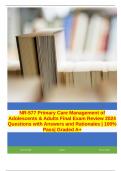NR-577 Primary Care Management of
Adolescents & Adults Final Exam Review 2024
Questions with Answers and Rationales | 100%
Pass| Graded A+
David Mungai [Date] [Course title]
, NR-577 Primary Care Management of
Adolescents & Adults Final Exam
Review 2024 Questions with Answers
and Rationales | 100% Pass| Graded A+
101. In differentiating between acute epididymitis and testicular
torsion, which key finding on physical exam should you expect to
see with acute epididymitis versus testicular torsion?
A. Positive Prehn's sign
B. Swelling of the effected testicle
C. Irritative voiding symptoms
D. Unilateral groin pain - Answer>> A.
Elevating the scrotum in acute epididymitis alleviates pain,
whereas in testicular torsion there is no difference in pain quality.
Swelling and unilateral groin pain will be present in both
conditions. Irritative voiding symptoms will occur with acute
epididymitis than testicular torsion
102. You are seeing a patient in the clinic who states he has tried
for over a year with his fiancé to conceive. His fiancé has a child
from a previous relationship. When reviewing medical history, a
history of _____ in adolescence would help to pinpoint a possible
cause of infertility?
A. Chickenpox
B. Wilson's disease
C. Mumps
D. Mononucleosis - Answer>> C.
In reviewing the history, an infection of mumps orchitis impairs
fertility in 13% of patients (Defendi, 2019). The other illnesses do
not impair fertility.
103. A 30-year old female is being seen in your office utilizing
sliding scale self-pay for monitoring of her INR on chronic
Coumadin therapy for an artificial valve. She states she had a
,positive pregnancy test and her last menstrual period was 8
weeks prior. She denies cramping or bleeding. The next course of
action is to:
A. Discontinue Coumadin and begin on a DOAC
B. Refer the patient to cardiology for management
C. Obtain a PT/INR and ensure dosage of Coumadin is at or
below 5mg/daily
D. Discontinue Coumadin and avoid blood thinners during the
pregnancy - Answer>> C.
Coumadin in the first trimester is safe at dosages of 5mg/day or
less (McPhee & Papadakis, 2018). The risks of stopping
Coumadin is greater for the mother than the developing fetus, so
discontinuing the medicine would not be appropriate. The patient
does not have insurance, so referring to cardiology would be an
expense the patient would not be able to afford. DOACs are not
recommended for mechanical valve replacements since there is
no data to support its use in pregnancy.
104 A 16-year-old female presents to the clinic stating she has
noticed a mass in her right breast. On examination, the mass is
2cm, mobile, rubbery, and nontender, located in the upper, outer
quadrant in the 10 o'clock position. Fibroadenoma is suspected.
What is the next step?
a. Observation
b. Surgical excision
c. Ultrasound
d. Biopsy - Answer>> A.
Fibroadenoma is common in adolescent girls. Diagnosed on
examination with findings of nontender, smooth, rubbery, well-
circumscribed, and mobile. Management is observation.
Fibroadenomas less than 5cm should be monitored over 3-4
months for growth or regression, then semiannually for a few
years, and then for regressing fibroadenomas yearly. Referral to
, breast specialist should be made if larger than 5cm, enlarging,
skin changes in overlying skin, or previous malignancy.
105. A 15-year-old female is brought into the clinic by her mother.
The mother is concerned she has not started her period.
Secondary sex characteristics are present, but no history of
menses. Patient denies being sexually active. Patient has not had
any recent illness and has no PMH. All of the following laboratory
test would be warranted except?
a. Urine pregnancy test
b. CBC
c. CMP
d. TSH, Prolactin, and FSH. - Answer>> C.
Primary amenorrhea- no menses or secondary sex characteristics
by 13y, or no menses or secondary sex characteristics by 15y.
Page 125 Figure 4-6 provides a guide to laboratory and radiologic
evaluation. Initial studies should include pregnancy test, CBC,
TSH, Prolactin, and FSH.
106. A 28 year old female presents to the office with a tender
lump in her left breast, approximately 1cm. She noticed the lump
right before she began her menstrual cycle 2 months ago. She
thought it was going away, but symptoms returned few days ago
before she started her menstrual cycle, again.
Which of the following diagnostic test would you order to for the
initial evaluation of the breast lump?
A. Core needle Biopsy
B. Ultrasonography
C. Excisional Biopsy
D. Mammography - Answer>> B.
Core needle biopsy is preferred over Fine needle biopsy, but not
for initial evaluation of a suspected fibrocystic condition.
Ultrasonography and mammography are the preferred initial





